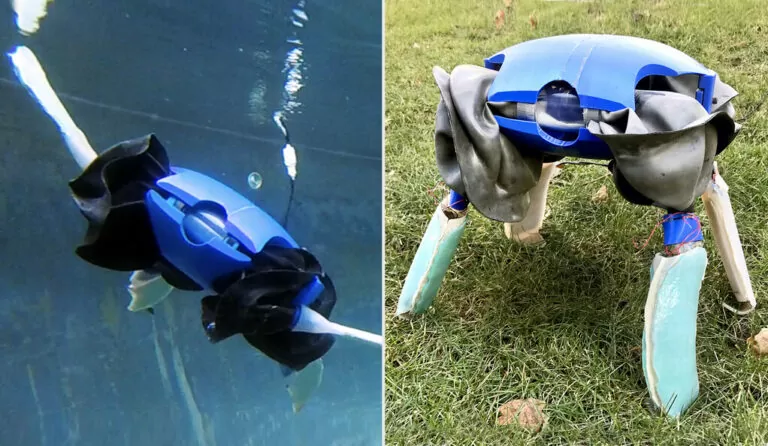
The project is described in the October 12 edition of Nature and is featured on the cover of the issue.
The robot, ART (Amphibious Robotic Turtle), takes inspiration from aquatic and terrestrial turtles, a group whose fossil record spans over 110 million years.
The robot is equipped with limbs that transform thanks to the adaptive morphogenesis and therefore they can adapt their shape, rigidity and behavior to the environment. The limbs use materials of varying stiffness and artificial muscles to transform their shape during the transition from one environment to another. In its state with legs, ART it can traverse the land with a variety of four-legged terrestrial gaits. After reaching a body of water, ART it can therefore transform its legs into fins, allowing it to swim with aquatic gaits based on lift and endurance.
ART it differs from other amphibious robots by exploiting the adaptation of the shape to use the same parts for propulsion both in water and on land. Other approaches add more propulsion mechanisms to the same robot, using a different one in each environment, which can lead to energy inefficiencies.
The potential applications are numerous. Kramer-Bottiglio's lab focused on applications that include monitoring ecosystems along the coast, supporting divers, and ocean agriculture. The robot will also help researchers study the physics of locomotion in the complex surf zone - where waves, currents and turbidity make navigation particularly difficult for robotic devices - and other environmental transition zones.
The research was done at the Yale University, Robert Baines, Sree Kalyan Patiballa (current affiliation, University of Alabama), Joran Booth, Luis Ramirez, Thomas Sipple, and Andonny Garcia; and from West Chester University, Frank Fish.
Staff BlogInnovazione.it
Google DeepMind is introducing an improved version of its artificial intelligence model. The new improved model provides not only…
Laravel, famous for its elegant syntax and powerful features, also provides a solid foundation for modular architecture. There…
Cisco and Splunk are helping customers accelerate their journey to the Security Operations Center (SOC) of the future with…
Ransomware has dominated the news for the last two years. Most people are well aware that attacks…
An ophthalmoplasty operation using the Apple Vision Pro commercial viewer was performed at the Catania Polyclinic…
Developing fine motor skills through coloring prepares children for more complex skills like writing. To color…
The naval sector is a true global economic power, which has navigated towards a 150 billion market...
Last Monday, the Financial Times announced a deal with OpenAI. FT licenses its world-class journalism…